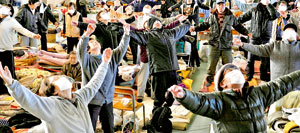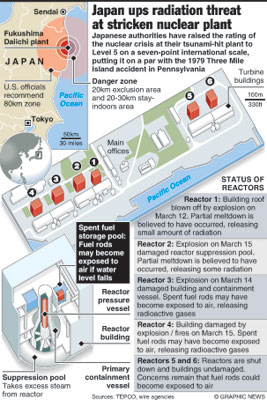KITAKAMI, Japan, March 19 (AFP) - Japanese crews fighting to cool overheating reactors laid a power line into a stricken nuclear power plant today as the government revealed abnormal levels of radioactivity in milk and spinach.
The Fukushima No. 1 plant was crippled eight days ago by a terrifying earthquake and tsunami which, according to the latest police tally, left at least 18,000 dead or missing in Japan's worst natural disaster since 1923.
 |
| People exercise at a gymnasium that was converted into an evacuation centre in Rikuzentakata City in Iwate Prefecture in this picture taken by Kyodo News. Reuters |
Just under 7,200 were confirmed killed, lost to the tsunami or interred in the wreckage of buildings. Sick and hungry survivors of the disaster are enduring desperate and bitterly cold conditions in the northeast.
The government of the world's third-biggest economy has been insisting that there is no widespread threat of radiation but confirmed that fresh foodstuffs were now showing signs of contamination.
The contaminated milk was found in Fukushima prefecture while the tainted spinach was discovered in neighbouring Ibaraki prefecture, chief government spokesman Yukio Edano told reporters.
The milk was found more than 30 kilometres (20 miles) from the plant, beyond a government exclusion zone.
But Edano urged consumers to remain calm, saying that even if a person were to drink the contaminated milk for a year, the radiation level would be the equivalent of one CT hospital scan.
Edano said the health ministry had ordered authorities in both prefectures to investigate where the products came from, how they were distributed and -- depending on their findings -- suspend sales.
“The government will do its utmost... to avoid health hazards and to resolve this problem,” he said.
Engineers fighting to restore mains electricity at the overheating reactors laid the power line into the plant 250 kilometres (155 miles) northeast of Tokyo, and said they would continue pumping in seawater round the clock.
The threat of radiation seeping from the ageing plant carried a particular resonance for Ayako Ito, who at 84 is old enough to recall the World War II US atom bomb attacks on the cities of Hiroshima and Nagasaki.
“The most difficult part is that you can't see it but people can just disappear like that,” she told AFP at her hillside home in Kamaishi, one of the northeast coastal towns that bore the full force of the towering tsunami.
“We're already not eating or drinking, and now this is happening to us? It's very difficult,” she said.
Half a million homeless people in Japan's northeast are struggling to stay warm in freezing temperatures and with scant supplies of food and fuel, after the March 11 tsunami reduced whole towns and villages to splintered matchwood.
Yukiko Sakai, 33, said she had not seen her husband Kenji, whom she married on December 24, since the disaster.
Today, for the second time, she visited a stadium that has been converted into a temporary morgue in Miyagi prefecture's Rifu city.
“If I don't find him here, that means he is still alive somewhere,” she said, refusing to give up hope.
Well south at the Fukushima No. 1 atomic plant, crews were locked in what the UN's nuclear watchdog said was a “race against time” to cool the reactors and prevent a major radiation leak after a series of explosions and fires.
After an epic week-long tussle to control the facility, where the tsunami knocked out all-important backup generators, the crews were expecting Saturday to restore electricity to four of its six reactors, officials said.
The nuclear safety agency said workers had got the power line into the plant after the 9.0-magnitude earthquake -- the biggest in Japan's recorded history -- felled electricity pylons in the area.
Once power is back up, the radiation-suited Fukushima engineers hope they can get vital cooling systems online. In the meantime, they have been dumping water by hose and by air on the reactors to avert a feared meltdown.
But given the extent of damage at the plant, it is unclear whether the cooling system would work even if power is restored.
The lack of power has sent the temperatures of fuel rods -- both in the reactors and in separate containment pools -- soaring as the coolant water that normally keeps them safely submerged has rapidly evaporated.
Coming on top of the natural disaster, the nuclear emergency has stoked anxiety among governments and the public worldwide, with panic-buying of iodine pills in several countries, and contributed to turmoil on financial markets.
But in a televised address Friday evening, Prime Minister Naoto Kan recalled Japan's recovery from the ashes of World War II and promised: “We will overcome this tragedy and recover... We will once more rebuild Japan.”Japan and its G7 economic allies on Friday intervened jointly in world currency markets for the first time in a decade to calm the turmoil, pushing down the yen as intended and helping to lift battered Tokyo shares.
Japan's nuclear agency has hiked the Fukushima accident level to five from four on an international scale measuring up to seven, an admission the crisis now at least equals the 1979 Three Mile Island accident in Pennsylvania.
But despite official reassurances, fears of radiation are only compounding the acute stress of survivors huddled in shelters who lost their homes and loved ones to the quake-tsunami disaster.
A major international relief operation is under way for the homeless and millions left without water, electricity, fuel or enough food in Japan's northeast.
But thick snow has covered the wreckage littering obliterated towns and villages, all but extinguishing hopes of finding anyone else alive in the sea of carnage.“A lot of people have been having respiratory problems. We can monitor it, but we cannot do much more than that,” said hospital surgeon Lee Yang-Sung, who is helping to treat patients evacuated to a spartan shelter in Kesennuma.
“We don't have hot water to keep their bodies clean and bed sores are becoming increasingly common,” Lee said. “We are reaching our limit.”Construction of about 200 temporary housing units began in the devastated coastal city of Rikuzentakata in Iwate prefecture, which plans to eventually build thousands of such homes.
And there was some relief from a slight rise in daytime temperatures, which melted the snow in some areas today.
Japan royals to skip Prince William's wedding
TOKYO, March 19 (Reuters) - Japan's crown prince and princess will skip Britain's royal wedding next month because of the earthquake and tsunami that devastated northeast Japan last week, Kyodo news agency said.
Crown Prince Naruhito and Crown Princess Masako had planned to attend the wedding of Prince William and fiancìe Kate Middleton on April 29. |



